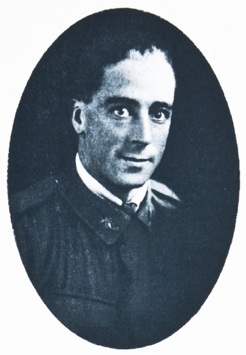POYNDER, George Halford (1894-1969)
POYNDER, George Halford MM (1894-1969)
George Halford Poynder was born on 3 October 1894, the son of the Rev. George Poynder and Alice Emily nee Hennell. He was enrolled as a boarder at Geelong College in 1908, leaving in 1910. His address at enrolment was The Vicarage, Dunolly. He commenced working for the Bank of New South Wales, Melbourne on 22 June 1912
 He enlisted (No. 30) in the AIF on 17 August 1914, and served with the Machine Gun Section, 6 Battalion, on Gallipoli. Ron Austin in As Rough As Bags described his wounding at German Officers' Trench:
He enlisted (No. 30) in the AIF on 17 August 1914, and served with the Machine Gun Section, 6 Battalion, on Gallipoli. Ron Austin in As Rough As Bags described his wounding at German Officers' Trench:
‘On the previous night (26-27 July 1915), the enemy shelling resulted in the No 2 machine gun being demolished and the crew of Privates Oliver1, Poynder and McDowell2 were temporarily buried in the cave in of the trench. It was during this period of heavy shelling that Corporal Fred Chambers (of Kew) kept his machine gun operating throughout the bombardment without concern to his own safety, and was subsequently awarded the Military Medal.'
The New South Wales Roll of Honour described his service: 'Embarking on 21st October 1914 for Egypt, he served right through the Gallipoli campaign from the Landing to the Evacuation and took part in the battles at Lone Pine and Cape Helles. On returning to Egypt he formed part of the Suez Canal Garrison, gaining promotion to the rank of sergeant in March 1916.
Afterwards he went on to France and served there and in Belgium, taking part in the Battle of Pozieres, Bullecourt, Lagnicourt, the three Battles of Passchendale, Nieppe Forest, etc, until he was gassed in May 1918. He was sent to a hospital in England and returned to Australia in January 1919. '
Sergeant Poynder transferred to 1st Machine Gun Battalion in France. He embarked for return to Australia on 16 December 1918.
He died in 1969
1 Cecil Stanley Oliver, later a lieutenant, the son of Arthur George and Grace Oliver, of East Malvern, 6 Battalion att. 2nd Machine Gun Company, died of wounds 31 July 1916, aged 23, and buried at Warloy-Baillon Communal Cemetery Extension - Grave LD.13.
2 Pte Richard McDowell, of Bendigo, was wounded in action, and returned to Australia embarking on 3 March 1916.
George Halford Poynder was born on 3 October 1894, the son of the Rev. George Poynder and Alice Emily nee Hennell. He was enrolled as a boarder at Geelong College in 1908, leaving in 1910. His address at enrolment was The Vicarage, Dunolly. He commenced working for the Bank of New South Wales, Melbourne on 22 June 1912
 He enlisted (No. 30) in the AIF on 17 August 1914, and served with the Machine Gun Section, 6 Battalion, on Gallipoli. Ron Austin in As Rough As Bags described his wounding at German Officers' Trench:
He enlisted (No. 30) in the AIF on 17 August 1914, and served with the Machine Gun Section, 6 Battalion, on Gallipoli. Ron Austin in As Rough As Bags described his wounding at German Officers' Trench: ‘On the previous night (26-27 July 1915), the enemy shelling resulted in the No 2 machine gun being demolished and the crew of Privates Oliver1, Poynder and McDowell2 were temporarily buried in the cave in of the trench. It was during this period of heavy shelling that Corporal Fred Chambers (of Kew) kept his machine gun operating throughout the bombardment without concern to his own safety, and was subsequently awarded the Military Medal.'
The New South Wales Roll of Honour described his service: 'Embarking on 21st October 1914 for Egypt, he served right through the Gallipoli campaign from the Landing to the Evacuation and took part in the battles at Lone Pine and Cape Helles. On returning to Egypt he formed part of the Suez Canal Garrison, gaining promotion to the rank of sergeant in March 1916.
Afterwards he went on to France and served there and in Belgium, taking part in the Battle of Pozieres, Bullecourt, Lagnicourt, the three Battles of Passchendale, Nieppe Forest, etc, until he was gassed in May 1918. He was sent to a hospital in England and returned to Australia in January 1919. '
Sergeant Poynder transferred to 1st Machine Gun Battalion in France. He embarked for return to Australia on 16 December 1918.
He died in 1969
1 Cecil Stanley Oliver, later a lieutenant, the son of Arthur George and Grace Oliver, of East Malvern, 6 Battalion att. 2nd Machine Gun Company, died of wounds 31 July 1916, aged 23, and buried at Warloy-Baillon Communal Cemetery Extension - Grave LD.13.
2 Pte Richard McDowell, of Bendigo, was wounded in action, and returned to Australia embarking on 3 March 1916.
Source
Bank of New South Wales Roll of Honour, 1921 p323; Geelong Collegians at the Great War compiled by James Affleck. p 285 (citing The Pegasus; Ron Austin, As Rough As Bags: The History of the 6th Battalion, 1st AIF, 1914-1919; National Archives).